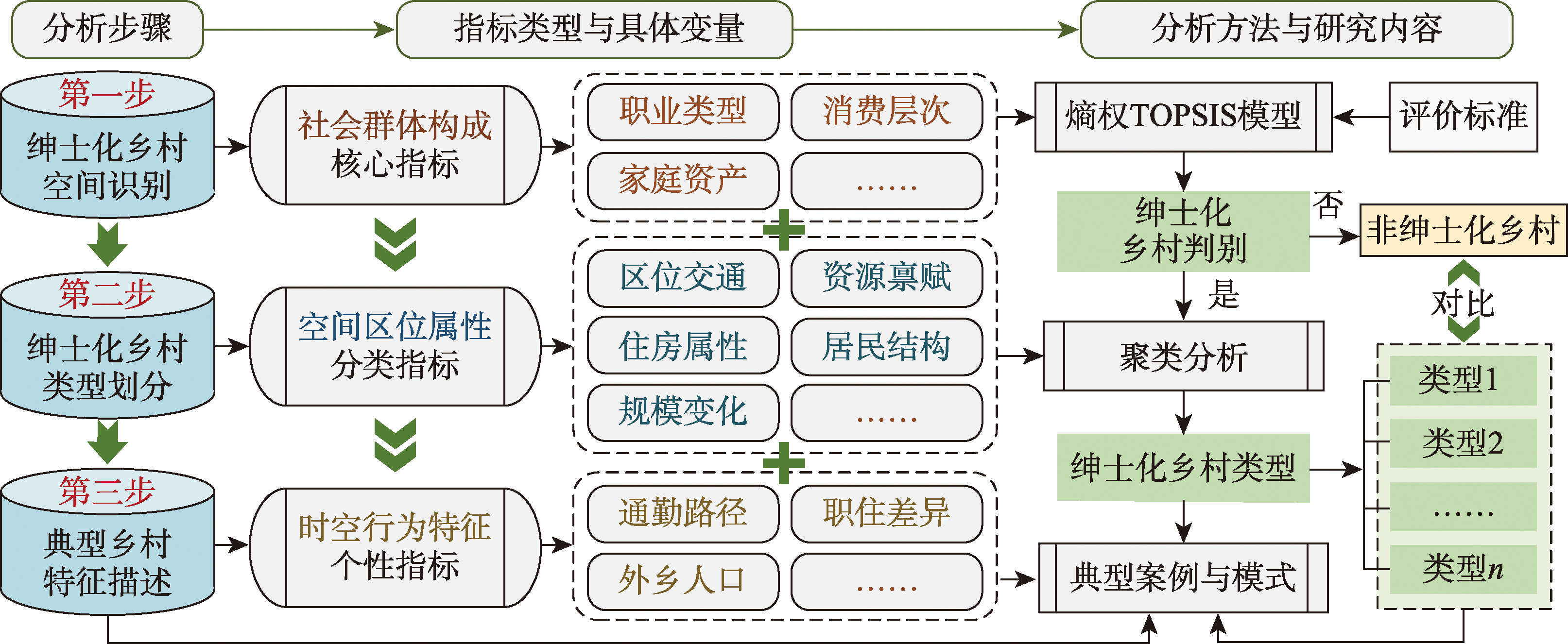

南京绅士化乡村的类型辨识与特征刻画
|
宋伟轩(1981-), 男, 吉林敦化人, 博士, 研究员, 研究方向为城市社会地理。E-mail: wxsong@hhu.edu.cn |
收稿日期: 2023-11-22
修回日期: 2024-08-05
网络出版日期: 2025-03-25
基金资助
国家自然科学基金项目(42171234)
国家自然科学基金项目(42361033)
Identification and characterization of rural gentrification in Nanjing
Received date: 2023-11-22
Revised date: 2024-08-05
Online published: 2025-03-25
Supported by
National Natural Science Foundation of China(42171234)
National Natural Science Foundation of China(42361033)
中国乡村绅士化研究偏重小微尺度的个案描述与质性分析,缺乏中宏尺度绅士化乡村的量化识别与类型研究。以南京534个乡村社区为研究对象,采用手机用户画像数据,结合定量评价聚类模型和典型案例比较方法,对东部经济发达地区绅士化乡村进行空间甄别、类型划分与特征刻画。根据绅士化乡村的空间区位、资源禀赋和主体行为属性,综合辨识出旅游文创型、企业带动型、舒适移民型和城郊通勤型4类绅士化乡村。旅游文创型乡村依托自然与文化资源,吸引资本商业开发、城市游客消费和村民自主经营,呈现旅游驱动的社区自我绅士化特征;企业带动型乡村依靠加工制造企业培育吸聚非农从业人口,体现出东部发达地区乡村绅士化特色;舒适移民型乡村凭借舒适康养资源,通过打造完整社区形成舒适移民与度假旅游的社区氛围,形塑“外源主动输入式”绅士化特征;城郊通勤型乡村依托区位与“租差”优势,招徕房地产资本投资,年轻白领群体往返于城乡“钟摆式”工作和生活,呈“外源整体植入式”绅士化特点。南京乡村绅士化主要遵从“区位—资源”规律,受“内生—外源”驱力交互作用。在“星球绅士化”语境下,可为中国特色乡村绅士化理论发展提供东部地区案例支撑,形成对都市区乡村振兴与城乡融合发展的政策启示。

宋伟轩 , 谭华云 , 叶玲 , 曹辉 . 南京绅士化乡村的类型辨识与特征刻画[J]. 地理学报, 2025 , 80(3) : 811 -827 . DOI: 10.11821/dlxb202503015
The phenomenon of gentrification in rural areas has garnered increasing attention both domestically and internationally in recent years. However, there is a prevailing inclination towards qualitative analysis at the level of case studies, with a lack of quantitative identification and comparative research at the regional or urban scale. To understand the distribution pattern and socio-spatial characteristics of gentrified villages in the metropolitan areas of eastern China, this paper focuses on 534 rural communities in Nanjing as the research subject. Leveraging mobile user profile data and quantitative evaluation clustering models, 36 gentrified villages were chosen and categorized into four types according to their spatial location, resource endowments, and behavioral attributes: Tourism and cultural-creative, enterprise-driven, amenity-immigrant, and suburban-commuter. As urban residents are relocated to villages with varying locations and resource endowments, they demonstrate differences in their motives for reverse migration, social attributes, and life patterns. This dynamic contributes to the emergence of various types of gentrified villages and the evolution of their distinct social environments. Additionally, this study highlights significant distinctions among these categories of gentrified villages in terms of their scale distribution, material spatial structure, social characteristics of residents, and daily commuting patterns. This comparison is conducted from a broad perspective and through typical case studies. Tourism and culturally creative villages rely on natural and cultural resources to attract urban tourists and foster self-gentrification among villagers due to their authentic and experiential allure. On the other hand, enterprise-driven villages, commonly found in developed areas in the east, promote gentrification through industrial resources, attracting populations beyond agriculture. Moreover, amenity-immigrant villages capitalize on limited comfort amenities to attract urban immigrants and short-term vacationers, fostering cohesive communities. Furthermore, suburban-commuter villages represent transitional entities in the transformation from rural outskirts to urbanized areas, where the overall substitution of physical and social spaces serves as the main mechanism for aggregating gentrification groups. Tourism and culturally creative villages, along with amenity-immigrant-gentrified villages, fall under the category of leisure and lifestyle gentrification. Conversely, enterprise-driven and suburban-commuter-gentrified villages focus on production and employment, reflecting the distinctive characteristics of rural gentrification in the developed regions of eastern China. By thoroughly identifying Nanjing's gentrified villages and systematically depicting their socio-spatial features, this study both enriches Chinese case studies on rural gentrification and enhances China-specific rural gentrification research systems and theories. Moreover, it proposes to develop the positive economic and social effects of rural gentrification to promote rural revitalization and integrated urban-rural development.

Key words: rural gentrification; gentrified villages; gentrification; social space; Nanjing
表1 绅士化乡村判别因子及描述Tab. 1 Identification factors and descriptions of gentrified rural areas |
| 因子 | 指标 | 备注 |
|---|---|---|
| 职业类型 | 白领职业群体占比(%) | 根据手机定位结合线上线下行为特征 |
| 消费层次 | 高消费群体占比(%) | 根据手机用户线上消费和线下刷卡数据 |
| 家庭资产 | 有房/有车群体占比(%) | 拥有私有住房与拥有私家车群体比例之和 |
| 规模变化 | 人口增长幅度(%) | 2018—2020年居住人口数量增长幅度 |
| 空间区位 | 与城市的空间关系(m) | 乡村社区居委会与城市边界的最短距离 |
| 住房属性 | 商品房开发规模(套) | 乡村内部是否存在商品房以及开发套数 |
| 自然禀赋 | 与景观资源的关系(m) | 与最近大型山水景观资源的距离 |
| 旅游资源 | 旅游景点数量(个) | 拥有风景名胜/纪念场馆/旅游景点数量 |
| 产业经济 | 公司企业数量(个) | 社区内部以及周边1 km范围内公司企业数量 |
| 职住差异 | 夜间人口/日间人口(%) | 夜晚居住人口与日间活动人口数量的比值① |
| 外乡人口 | 外乡人口占比(%) | 非南京本市的外地人口占全部居民的比例 |
注:数据来源为“个推”(getui.com)、高德地图(amap.com)、中国房价行情平台(creprice.cn)。 |
① ① 为真实反映居民日常行为规律,降低因随机偶发事件造成的干扰,剔除上下班交通和早晚用餐高峰时段,根据手机用户实时位置数据,将该月内每天10:00—17:00累计出现最久的位置定义为工作地(包括未就业、待/失业、灵活就业、居家办公和退休居家等情况),每天21:00—次日06:00出现最久的位置作为居住地。
| [1] |
|
| [2] |
|
| [3] |
[ 陈培阳. 西方绅士化研究进展. 城市规划, 2021, 45(1): 94-104.]
|
| [4] |
|
| [5] |
|
| [6] |
|
| [7] |
|
| [8] |
[ 谭华云, 周国华. 基于行动者网络理论的乡村绅士化演化过程与机制解析: 以广西巴马盘阳河流域为例. 地理学报, 2022, 77(4): 869-887.]
|
| [9] |
|
| [10] |
[ 谭华云, 许春晓. 舒适移民型乡村绅士化空间格局及其形成机制: 以广西巴马盘阳河流域为例. 旅游学刊, 2021, 36(2): 40-53.]
|
| [11] |
[ 王华, 苏伟锋. 旅游驱动型乡村绅士化过程与机制研究: 以丹霞山两村为例. 旅游学刊, 2021, 36(5): 69-80.]
|
| [12] |
[ 谭华云, 周国华. 地理学视角的乡村绅士化研究框架. 经济地理, 2022, 42(11): 173-184.]
|
| [13] |
|
| [14] |
|
| [15] |
[ 卢松, 张海, 饶小芳. 西方乡村绅士化研究进展. 人文地理, 2019, 34(3): 1-6.]
|
| [16] |
|
| [17] |
[ 杨雪珂, 徐红罡. 艺术家影响下乡村绅士化与旅游发展的相互作用: 以成都明月村为例. 旅游学刊, 2023, 38(4): 15-25.]
|
| [18] |
[ 魏星怡, 段德罡. 我国乡村绅士化的研究综述. 当代建筑, 2023, 42(6): 129-132.]
|
| [19] |
|
| [20] |
|
| [21] |
[ 何深静, 钱俊希, 徐雨璇, 等. 快速城市化背景下乡村绅士化的时空演变特征. 地理学报, 2012, 67(8): 1044-1056.]
|
| [22] |
[ 张娟, 王茂军. 乡村绅士化进程中旅游型村落生活空间重塑特征研究: 以北京爨底下村为例. 人文地理, 2017, 32(2): 137-144.]
|
| [23] |
[ 蔡晓梅, 刘美新, 林家惠, 等. 旅游发展背景下乡村绅士化的动态表征与形成机制: 以广东惠州上良村为例. 旅游学刊, 2021, 36(5): 55-68.]
|
| [24] |
[ 储德平, 黄成昆. 旅游发展背景下乡村自我绅士化的过程与机制: 以陕西袁家村为例. 地理研究, 2023, 42(7): 1856-1873.]
|
| [25] |
[ 谭华云, 许春晓. 舒适移民驱动的乡村绅士化发展特征与机理分析: 以巴马盘阳河流域长寿乡村为例. 经济地理, 2019, 39(1): 207-214.]
|
| [26] |
|
| [27] |
|
| [28] |
[ 马仁锋, 王腾飞, 张文忠. 创意再生视域宁波老工业区绅士化动力机制. 地理学报, 2019, 74(4): 780-796.]
|
| [29] |
[ 卢松, 陈路桥, 龙澄, 等. 中国大城市郊区传统村镇旅游绅士化研究: 以上海市朱家角古镇为例. 地理学报, 2023, 78(10): 2535-2553.]
|
| [30] |
|
| [31] |
|
| [32] |
[ 刘彦随, 龙花楼, 李裕瑞. 全球乡城关系新认知与人文地理学研究. 地理学报, 2021, 76(12): 2869-2884.]
|
| [33] |
|
| [34] |
|
| [35] |
|
| [36] |
[ 刘守英, 王一鸽. 从乡土中国到城乡中国: 中国转型的乡村变迁视角. 管理世界, 2018, 34(10): 128-146.]
|
| [37] |
[ 钱文荣, 郑淋议. 构建城乡人口双向流动与融合的制度保障体系: 从权利开放理论到村庄开放实践的分析线索. 南方经济, 2021(8): 24-34.]
|
| [38] |
[ 周国华, 龙花楼, 林万龙, 等. 新时代“三农”问题和乡村振兴的理论思考与实践发展. 自然资源学报, 2023, 38(8): 1919-1940.]
|
| [39] |
[ 唐承丽, 贺艳华, 周国华, 等. 基于生活质量导向的乡村聚落空间优化研究. 地理学报, 2014, 69(10): 1459-1472.]
|
| [40] |
[ 黄成昆, 储德平, 王兰兰, 等. 日常生活视域下乡村外来旅游创业者的地方身份建构: 以陕西袁家村为例. 世界地理研究, 2023, 32(5): 125-137.]
|
| [41] |
[ 宋伟轩, 曹辉, 涂唐奇, 等. 南京主城区优质教育资源导向的学区绅士化研究. 地理学报, 2023, 78(4): 792-810.]
|
| [42] |
[ 宋伟轩, 王捷凯, 金荷仙, 等. 城市景观绅士化社会空间特征、机制与效应: 以南京为例. 经济地理, 2023, 43(11): 104-114.]
|
/
| 〈 |
|
〉 |